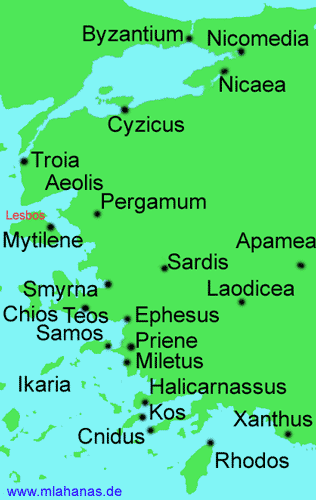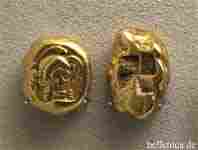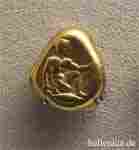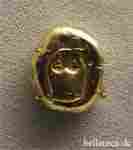.

Cyzicus (Greek: Κύζικος) was an ancient town of Mysia in Asia Minor, situated on the shoreward side of the present peninsula of Kapu-Dagh (Arctonnesus), which is said to have been originally an island in the Sea of Marmara, and to have been artificially connected with the mainland in historic times.
Now, Cyzicus is protected by the Republic of Turkey's Ministry of Culture, and located on the Erdek and Bandırma roads in Turkey.
History



The city was probably founded by Pelasgians from Thessaly, according to tradition at the coming of the Argonauts; later it received many colonies from Miletus, allegedly in 756 BC, but its importance began only after the Peloponnesian war, when the decay of Athens and Miletus set in. Alcibiades defeated the Lacedaemonians there (410 BC).
The era of its Olympiads was reckoned from 135 or 139.
Owing to its advantageous position it speedily acquired commercial importance, and the gold staters of Cyzicus were a staple currency in the ancient world till they were superseded by those of Philip of Macedon. Its unique and characteristic coin, the Cyzicenus, was worth 28 drachmae.
During the Peloponnesian War (431-404 BC) Cyzicus was subject to the Athenians and Lacedaemonians alternately. In the naval Battle of Cyzicus in 410 during the Peloponnesian War, an Athenian fleet routed and completely destroyed a Spartan fleet. At the peace of Antalcidas (387 BC), like the other Greek cities in Asia, it was made over to Persia. Alexander the Great later captured it from the Persians in 334 BC.
The history of the town in Hellenistic times is closely connected with that of the Attalids of Pergamon, with whose extinction it came into direct relations with Rome. Cyzicus was held for the Romans against king Mithridates VI of Pontus who besieged it with 300,000 men in 74 BC, but it withstood him stoutly, and the siege was raised by Lucullus: the loyalty of the city was rewarded by an extension of territory and other privileges. The Romans favoured it and recognized its municipal independence. Cyzicus was the leading city of Northern Mysia as far as Troas.
Under Tiberius it was incorporated with the empire, but remained the capital of Mysia, afterwards of Hellespontus, and became one of the greatest cities in the ancient world.
Cyzicus was captured temporarily by the Arabs in 675.
It appears to have been ruined by a series of earthquakes since 443 — the last in AD 1063; it began to be deserted as early as the eleventh century and the population was transferred to Artaki at least as early as the 13th century, when the peninsula was occupied by the Crusaders.
In the Ottoman era it was part of the caza of Erdek, in the Anatolian vilayet of Brusa.
Ecclesiastical history
A titular see of Asia Minor, metropolitan of the ancient ecclesiastical province of Hellespontus.
As ecclesiastical metropolis of the Roman Hellespontus province, Cyzicus had a catalogue of bishops beginning with the first century; Lequien (I, 747) mentions fifty-nine. A more complete list is found in Nicodemos, in the Greek "Office of St. Emilian" (Constantinople, 1876), 34-36, which has eighty-five names. Of particular importance are the famous Arian Eunomius; St. Dalmatius; St. Proclus and St. Germanus, who became Patriarchs of Constantinople; and St. Emilian, a martyr in the eighth century. Gelasius, an historian of Arianism, who wrote about 475, was born at Cyzicus. Lequien (III, 941) mentions a Latin bishop in 1477.
Cyzicus is still a metropolitan title for the Greek Orthodox, the metropolitan residing at Artake (Erdek), a little port on the western shore of the peninsula. Opposite to Artake is another port, Peramos (Perama), where an Assumptionist Father founded a Greek parish. At Panormos (Panderma), another more important port nine miles south-east of the ruins of Cyzicus (10,000 inhabitants), there is a Catholic Armenian parish. At the Dardanelles there is also a Latin parish. It remains a Catholic titular see.
Monuments
The site amid the marshes of Balkiz Serai is known as Bal-Kiz and entirely uninhabited, though under cultivation. The principal extant ruins are the walls, dating from the fourth century, which are traceable for nearly their whole extent, and the substructures of the temple of Hadrian, the ruins of a Roman aqueduct and a theatre.
The picturesque amphitheatre, intersected by a stream, built in the third century B.C., was one of the largest in the world; its diameter was nearly 500 feet. Of this magnificent building, sometimes ranked among the seven wonders of the ancient world, thirty-one immense columns still stood erect in 1444. These have since been carried away piecemeal for building purposes.
Colossal foundations of a temple dedicated to the emperor Hadrian are still visible: the columns were 21.35 metres high (about 70 feet), while the highest known elsewhere, those at Baalbek in Syria are only 19.35 metres (about 63 feet).
The monuments of Cyzicus were used by the Byzantine emperor Justinian as a quarry for the building of his Saint Sophia cathedral, and were still exploited by the Ottomans.
See also
Androsthenes of Cyzicus, 200 BC, accompanied Antiochus III the Great to India.
Eudoxus of Cyzicus, 130 BCE, navigator and explorer.
Erucius de Cyzicus, writer.
Gelasius of Cyzicus, 5th century ecclesiastical writer.
| Ancient Greece
Science, Technology , Medicine , Warfare, , Biographies , Life , Cities/Places/Maps , Arts , Literature , Philosophy ,Olympics, Mythology , History , Images Medieval Greece / Byzantine Empire Science, Technology, Arts, , Warfare , Literature, Biographies, Icons, History Modern Greece Cities, Islands, Regions, Fauna/Flora ,Biographies , History , Warfare, Science/Technology, Literature, Music , Arts , Film/Actors , Sport , Fashion --- |
Retrieved from "http://en.wikipedia.org/"
All text is available under the terms of the GNU Free Documentation License


